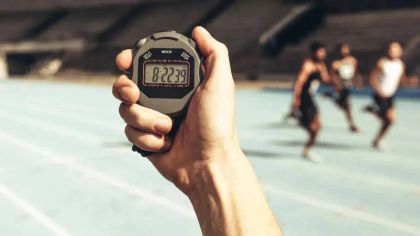"I don't have enough time to exercise!"
This is the #1 objection I hear against strength training and if you think that way, I get you.
The fitness industry makes it seem that you have to live in the gym to see great results - which can be frustrating, as this isn’t possible for you.
But the truth is that you can build your dream physique within 2 hours per week - if you do it right.
And it’s the best investment you can make:
Strength training is scientifically shown to improve your...
- Gut health
- Brain health
- Bone density
- Blood sugar levels
- Cardiovascular health
- Markers of chronic inflammation
It’s a literal health hack that you can’t ignore.
And if you want to cut body fat, it’s even more important. If you hop on a diet and neglect strength training, you will experience muscle loss.
As a result,
- You will look skinny-fat
- Your energy levels crash
- Your metabolism slows down
- You have to eat even less to drop body fat
- You set yourself up for the yo-yo effect due to these factors
It’s a terrible idea.
That’s why in this newsletter, I’ll show you the simplest way to build your dream physique, feel energized and well. And all that within 2 hours or less - in the gym or at home!
Are you wasting your time?
I've been working out since 2011. During these 12 years, I've experimented with countless workout routines:
- P90X
- Crossfit
- Strongman
- Plyometrics
- Powerlifting
- Calisthenics
- Bodybuilding
- Powerbuilding
- Hybrid training
- Circuit workouts
- Functional fitness
- 12-minute-ab-workouts
And many more.
There's been phases where I've experienced incredible progress within just 3 months, and phases where I stagnated for over a year. And I can guarantee you one thing from all these years of experience:
Getting excellent results is not a time issue.
In fact, 90% of people in the gym waste time through ineffective methods - and that's the real problem.
The 2-hour body
We will focus on three factors that will allow you to get amazing results in 2 hours per week. We'll also make sure that you can do it with the least amount of equipment.
Yes, you can make strength training more nuanced and complicated. But if you're like most and just want to maximize health, energy, and mental clarity - while still being strong and looking good - it's unnecessary.
Here’s what you don't need:
- Muscle confusion
- Complex periodization
- Long workout durations
- Advanced training splits
- Specialized equipment or facilities
- Zumba, group fitness courses, or trampoline workouts
Here’s what you do need:
- Progressive overload
- A simple but effective program
- Choosing the best exercises
Let’s start with exercise selection:
To maximize time efficiency, choose exercises that train several muscle groups at once. This keeps your workouts simple and allows you to leave the gym earlier and enjoy your day.
For that, I like to build workouts around core movement patterns. These patterns are:
- Squat
- Hip hinge
- Horizontal and vertical pull
- Horizontal and vertical press
They are perfect if you sit a lot (which you do) and they’ll help you build muscle, flexibility, and strength.
Squat:
Squats with the barbell are amazing, but my favorite variation for beginners is Split Squats. They’re easy to learn, you can do it anywhere and get great results with little weight.
In 2021, when gyms were locked down, I had a client build his legs like that - on his couch, with just dumbbells. If you're a complete beginner, your body weight will already be challenging enough.
Split Squat is the perfect “anti-sitting” exercise because you strengthen your legs and build balance and mobility too.
Other great variations are:
- Lunges
- Goblet Squats
- Regular Back Squats
If you don't want to train with free weights and just care about building muscle, you could also do leg presses.
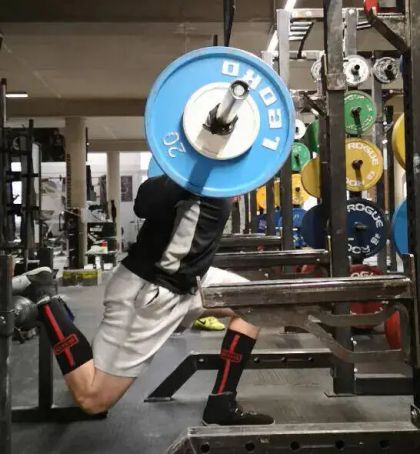
Split Squats
Hip Hinge:
A “Hip Hinge” is the extension of your hip, working your Glutes and Hamstrings. These muscles get weak during long hours of sitting, which causes issues with your posture and might lead to back pain.
Some great exercises to train this pattern are:
- Deadlift
- Romanian Deadlift
- Hyperextension machine
My recommendation is to start with Dumbbell Romanian Deadlifts or Hyperextensions. I wouldn’t deadlift from the floor until you’ve learned to do this movement properly. Otherwise, you’ll lose position and round with your lower back - increasing the risk of injuries.
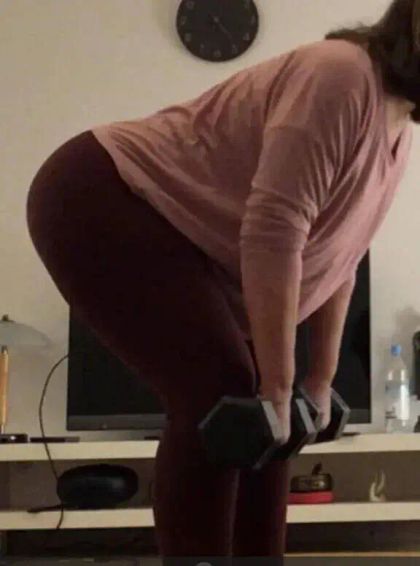
Dumbbell Romanian Deadlifts
Horizontal and vertical pull:
The most important horizontal pull exercise is the row.
There are hundreds of variations of rows, the one I like best for beginners is the dumbbell row. It’s easy to learn, all you need is a dumbbell and you can go heavy over time.
For vertical pull, the best exercises are variations of the Pull Up and Latpull.
Pull Ups are too advanced for most beginners, which is why I would focus on the Latpull at first.
If you want to train at home and don’t have a Lat Pull machine available, you have two options:
Get yourself a resistance band and attach it to your roof. Then pull it down with one hand as you would do in a regular lat pull. That way, you can do a one-arm lat pull variation.
Skip vertical pull for now and add more rows.
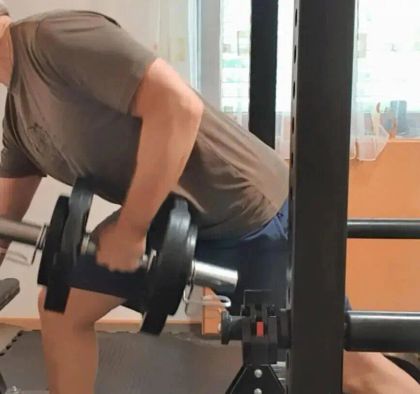
Dumbbell Row
Horizontal and vertical press:
There are two types of presses: Vertical and horizontal.
Vertical presses, such as the Dumbbell Overhead Press work mainly on your shoulders. Horizontal, such as Pushup or Bench Press focus more on your chest.
Both are important to build a strong upper body and posture, and they’ll prevent neck and shoulder tensions.
There’s a common belief that stretching relieves tension, but it's not enough because a tight muscle is also a weak muscle. I myself used to deal with them all the time in my teens, and I only got rid of them by building stronger shoulder muscles.
Here’s how I recommend you get started:
For the vertical press, the Seated Overhead Press on a flat bench (or couch or chair) is my favorite. It trains all parts of your shoulders and also requires stabilization. If you don’t have the mobility yet to perform it, start with the Wallslide to improve your mobility. When you can do them with your heels, hip, shoulders, and head resting against a wall, without overarching your lower back, you’re ready to transition.
For the horizontal press, you could start with Pushups or Dumbbell Incline Bench Press (if you have access to a gym). If a normal pushup is too difficult at first, increase the height of the position of your hands. The Dumbbell Incline Bench is easier to learn and you also can start with lighter weights than doing it with a barbell.
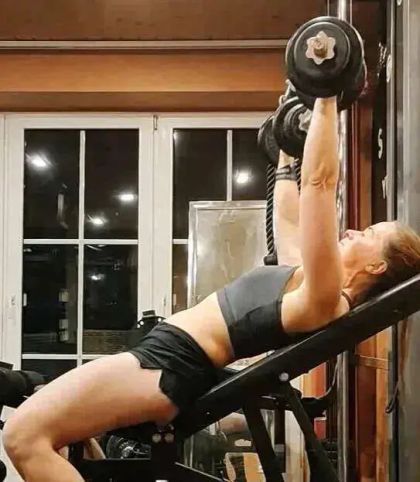
Dumbbell Bench Press
Core and rear shoulders:
Additionally, I like to add exercises for your core and the rear part of your shoulders. Training your core won’t just make your abs look better - it’s also important for your back to make up for your long hours of sitting.
Here are some great exercises to get started:
- Plank
- Deadbug
- Russian twist
Additionally, you can add exercises for the rear part of your shoulders like face pulls.
Next, create your program.
The #1 mistake you can make: Not having a program. Without a clear routine, you’ll end up dabbling around, never getting anywhere.
This is problematic with gym group classes, and even many personal trainers who just show you some exercises without a clear structure. If your PT does that, fire him, even if you’re tired after your workouts. Anyone can make you tired, but only a good trainer can make you strong.
Let's go through a simple workout, based on the movements covered above. Keep in mind that this is a minimalist approach. You can always add more if you like or adapt the exercises I selected here. Just make sure to start with a program that you’re 100% confident you can do long-term.
Day 1:
- Split Squat: 3 sets of 12 reps
- Dumbbell Row: 3 sets of 12 reps
- Pushup: 3 sets of 12 reps
- Plank: 3 sets, as long as you can hold
Day 2:
- Dumbbell Romanian Deadlift: 3 sets of 12 reps
- Lat Pull: 3 sets of 12 reps
- Dumbbell Overhead Press: 3 sets of 12 reps
- Dead bug: 3 sets, as many reps as you can
You'll complete these workouts within 30-45 minutes.
Lastly, focus on Progressive Overload
A big mistake that will ensure you waste your time at the gym is to focus on how much you sweat and equal that as progress.
Don’t get me wrong: Effort is important. But the true measurement is whether you can increase your workload over time. If you see change on the bar, you will see a change in the mirror.
Aim to increase your workload gradually every workout:
- One more rep
- 2.5 kg more on the bar
- Finish the set with more energy in the tank than you had last time.
For a full guide on how progressive overload works, click this link HERE.
Let’s put it all together:
Find 2-3 time slots where you can work out for 30-45 minutes - on a weekly basis and commit to these times. Treat them like you would treat important business meetings - time you invest in your body, health, and mental capabilities.
You might think you're too stressed to work out, but in reality, these time slots will help you to release stress by having time just for yourself. This can be in the gym or at home.
If you want to work out at home, invest in dumbbells where you can stack weight. You can get quality dumbbells for the investment of a 3-month membership in a decent gym, and it will greatly improve your options.
Start with the framework for workouts you’ve learned in this article and add more over time (if you want to).
Lastly, make sure to focus on progressive overload - that’s what will get you results in the long term.
If you want an individual roadmap to reach your dream physique in just 2 hours per week, click THIS link to hop on a free 1:1 strategy call with me.
